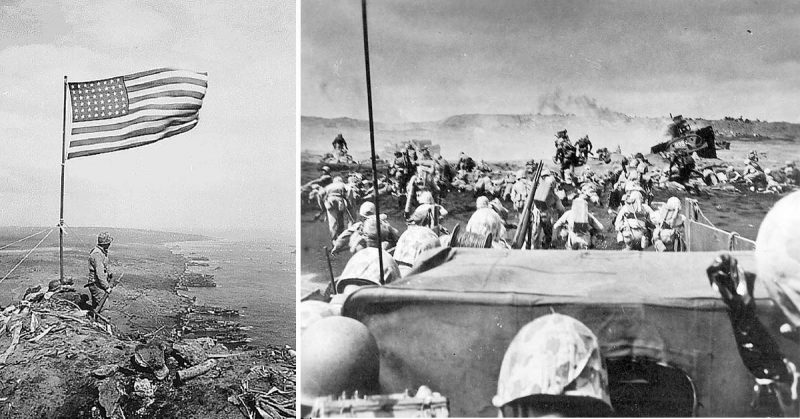The Battle of Iwo Jima was more than just another strategic island fight in the US military’s struggle with Imperial Japan during World War Two. It was a key stepping stone for the planned invasion of Japan. It was a battle with heavy losses, great heroism, and eventual controversy. And it became immortalised in one of the most famous movies in military history.
1. The Unsinkable Aircraft Carrier
By the start of 1945, the American military were planning an invasion of Japan, intended to take that country out of the Second World War. In preparation, they began bombing campaigns against the Japanese mainland, softening it up ready for the attack. Everyone knew that it would be a brutal struggle – the Japanese were fighting tenaciously for every inch of ground, and would be even more determined in defending their homeland. But with the Manhattan Project still a closely guarded secret, to most people it looked like the only way to win the war.
Taking off from the Mariana Islands, B-29 Superfortresses took 3000 mile round trips to bomb Japan. It was a long journey, tough on the pilots, planes and fuel supplies. Flying so far from base, the Superfortresses lacked fighter protection, making them vulnerable to Japanese defenders. But there was an answer.
Iwo Jima, regarded by the Japanese as an unsinkable aircraft carrier, lay only 760 miles from Japan. The Japanese were using its fighter base and radar to take out the American bombers. Capturing it would be a double victory for the Americans – taking out those defences, and putting their own fighters close enough to support US bombers on raids over Japan.
2. Preparing the Defences
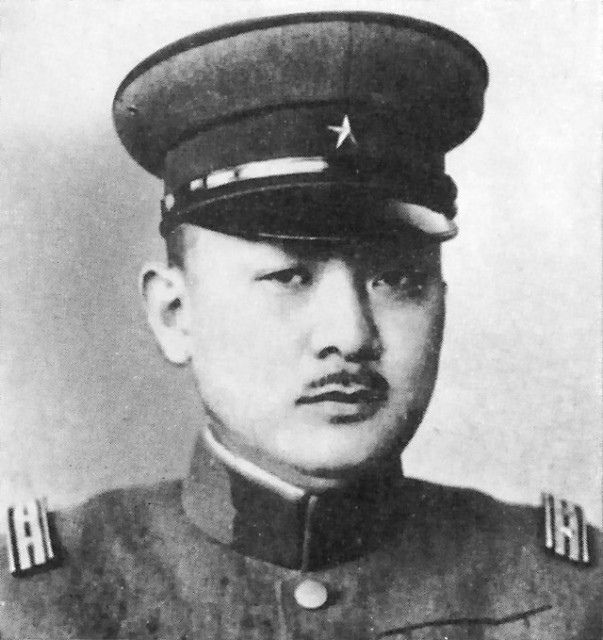
Five miles long and two-and-a-half miles wide at its broadest, Iwo Jima was the best-defended spot in Japan’s Pacific empire. Its tough defences were manned by 21,000 soldiers led by Lieutenant-General Kuribayashi Tadamichi. Delays in launching the invasion gave General Kuribayashi time to reinforce the defences, despite bomber attacks.
3. Bombardment
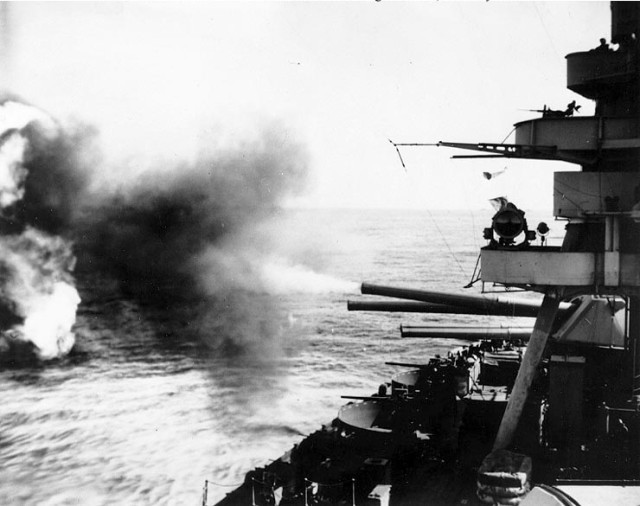
Before setting foot on the island, the Americans spent days softening up their target. Air strikes, rockets, napalm and the shells of naval guns pounded the defensive positions. Some bunkers and caves were destroyed, but the Japanese remained well dug in and determined. They had been preparing for this moment for nearly a year. They would not be easily broken.
4. The Landings
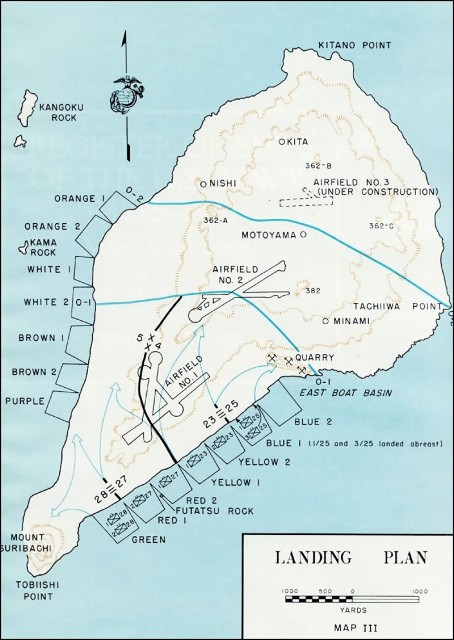
On the night of 18 February 1945, Admiral Raymond A. Spruance, overall commander of the invasion, arrived at Iwo Jima along with Task Force 58, a vast carrier fleet.
As 19 February began, landing craft headed toward the beaches under a clear, bright sky. There would be no helpful gloom or fog to help the marines and soldiers hide from enemy guns.
The first troops, mostly marines hit land at one minute to nine, welcomed by desultory fire from rifles and mortars. Crossing the beaches, they hit fifteen-foot slopes of ash that had been spewed out by the island’s volcanic mountains. This soft black mass was tough to cross, forcing men to abandon equipment to continue their advance. It was impossible to dig foxholes in ash, the upside being that it absorbed some enemy shrapnel.
The slow rate of fire from the defenders made the Americans think they would face little opposition from a broken Japanese force. They could not have been more wrong. Kuribayashi held back his men’s fire for an hour while the beaches became rammed full of troops and equipment. Then he unleashed the full fury of guns, mortars and artillery. Just after ten in the morning, a deadly barrage began.
5. Leaving the Beaches
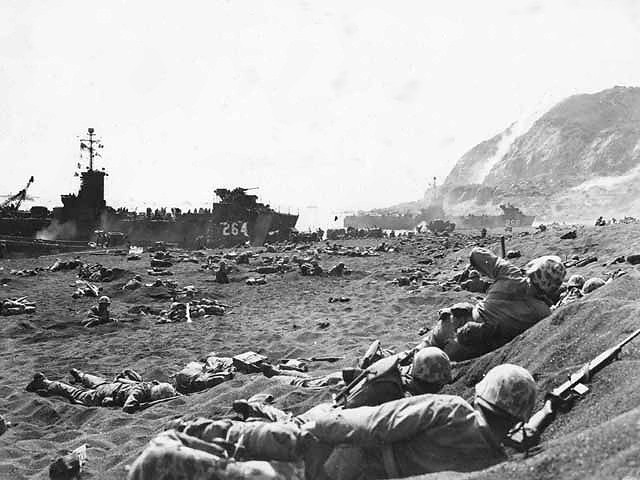
Under intense fire, the Americans pushed hard to get off the beaches and reach their objectives. Transport vehicles became bogged down in the ash, forcing men to slog through it on foot.
The Japanese held out in bunkers connected by a tunnel network. The Americans would clear out a bunker with grenades and flamethrowers then move on, only for the Japanese to reoccupy the bunker by underground routes and fire on them from behind.
By the end of 19 February, the 28th Marine Regiment had crossed the island at its narrowest point, where it was only half a mile across, cutting off the Japanese at Mount Suribachi. One of the two airfields had also been taken.
6. Raising the Flag
Fighting was intense over the next few days. Kuribayashi discouraged banzai charges, a common manoeuvre among the Japanese in the island war, in favour of more conventional drawn out defensive measures. But as food and water ran out, the Japanese became increasingly desperate. Night-time charges led to brutal hand-to-hand fighting.
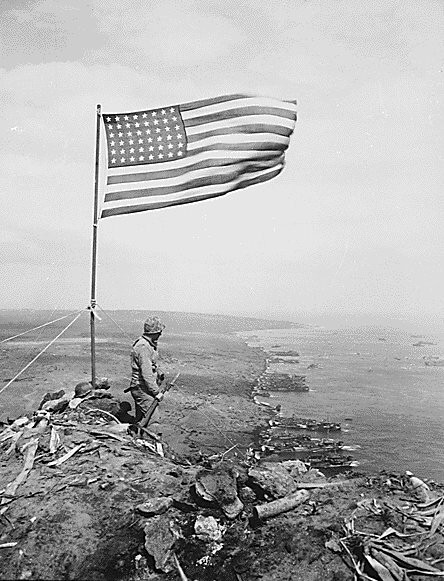
The capture of Mount Suribachi provided the most iconic moment of the battle. On 23 February, Joe Rosenthal took a photograph of six soldiers raising the US flag on the mountain. It was the second flag raised there, but it became a classic image of the moment of victory, hugely popular with the public and a winner of the Pulitzer Prize.
7. The North
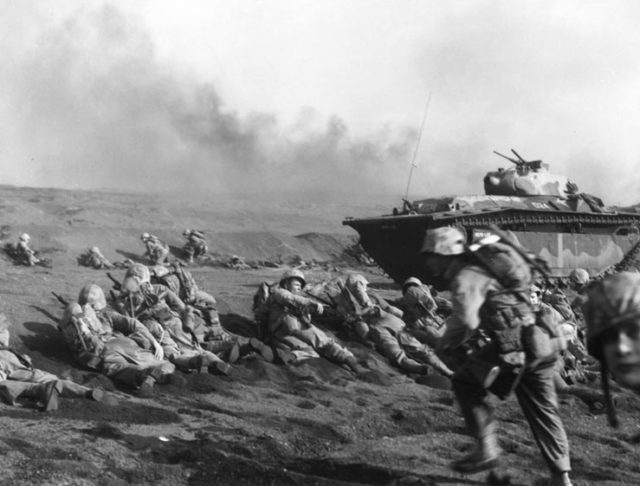
Fighting continued for over a month as the Japanese were pushed back into the northern end of the island.
The final Japanese counter-attack was launched on the night of 25 March. 300 men charged a captured airfield and fierce fighting followed. Accounts of the charge varied, but some have said that it was led by General Kuribayashi in person, departing from the death by seppuku, a common custom among failed or defeated Japanese commanders. The Japanese charged in silence, rather than with the usual banzai charge battle cry.
8. Death and Honor
Of 21,000 Japanese defending the island, 18,000 died in combat or from seppuku. The Americans suffered over 26,000 casualties, including 6,800 dead. Of 30,000 men who hit the beaches on the first day, 2,400 were wounded by enemy fire.
The men who fought at Iwo Jima displayed great courage on both sides. 27 Medals of Honor were awarded to US troops for their bravery in the battle.
The value of the battle remains controversial. Few fighter escort missions were ever flown from the island, and it was of little use to the army or navy. The atom bomb would ensure that the invasion of Japan never took place. But it could have been a valuable asset, and it was one more dent in the Japanese defences and another milestone on the way to American victory in the Pacific..
